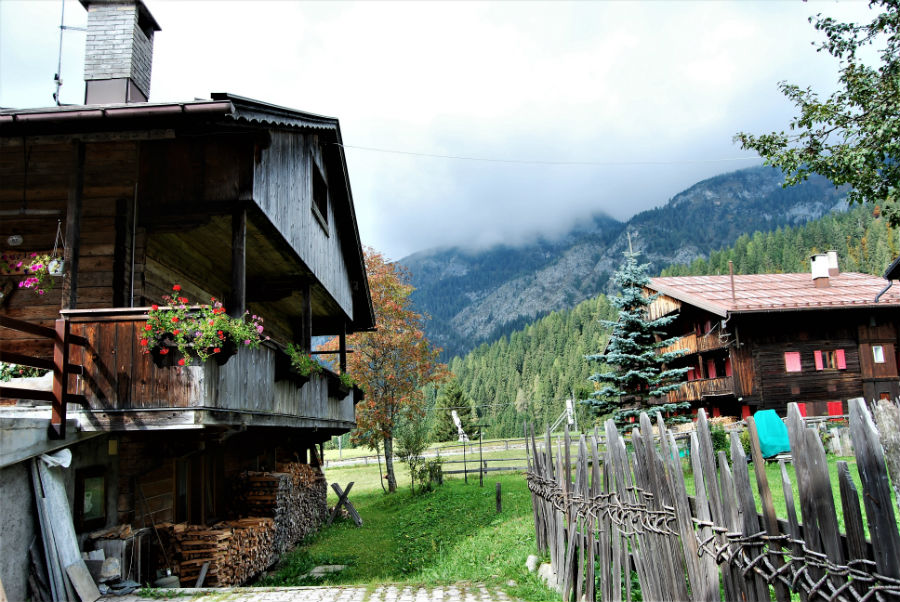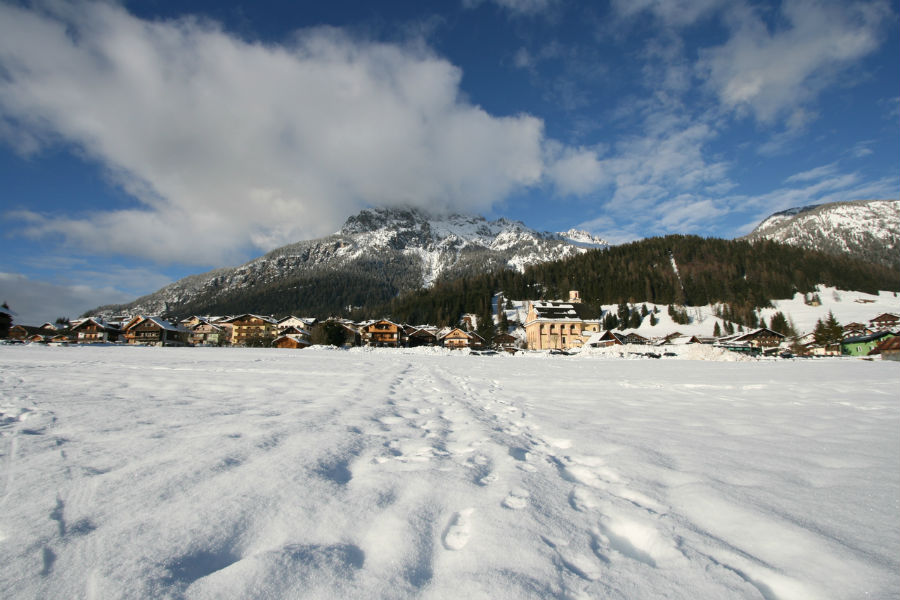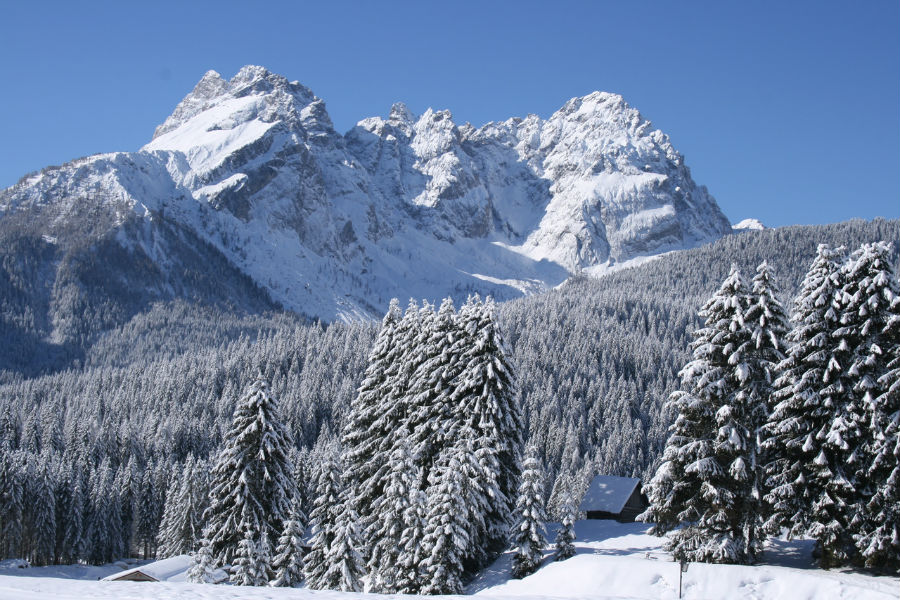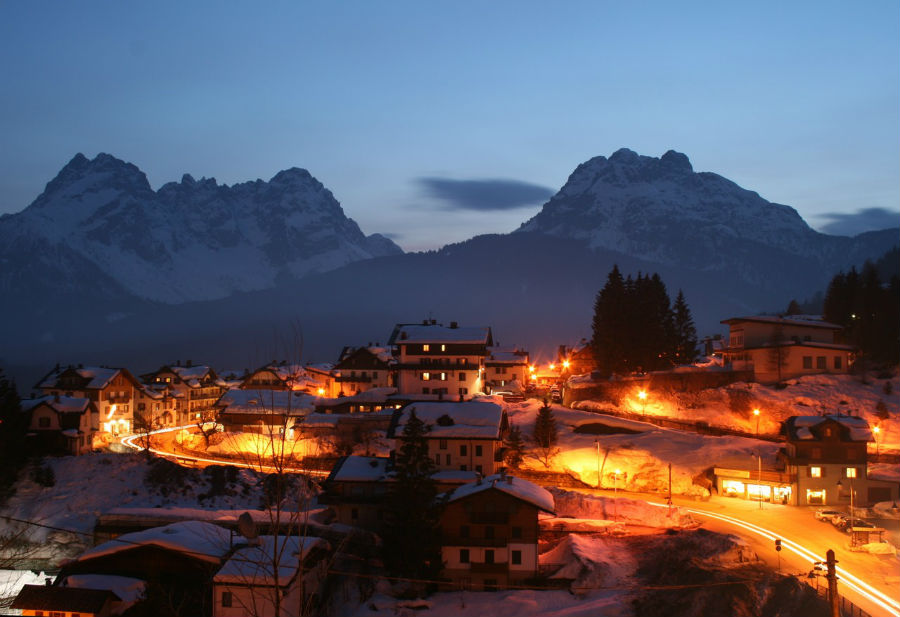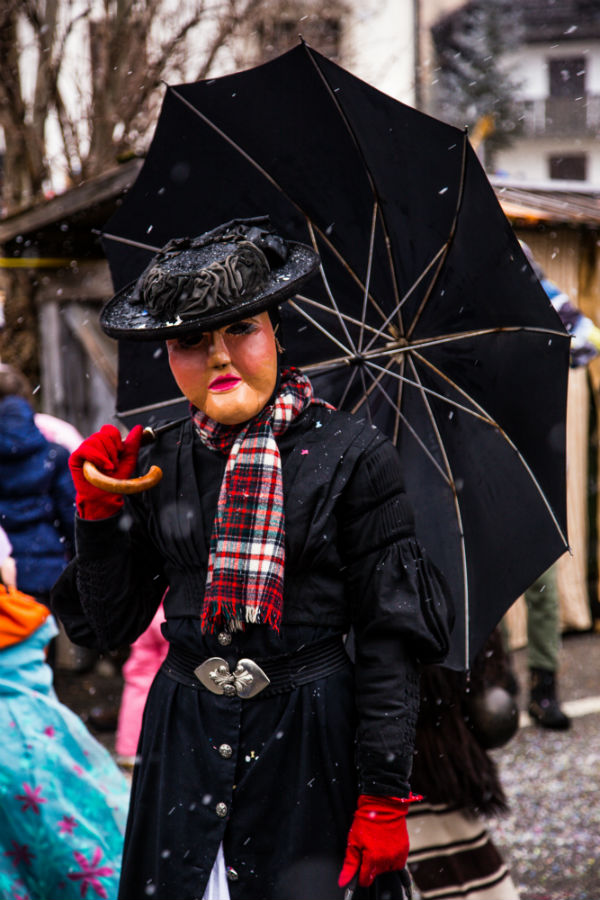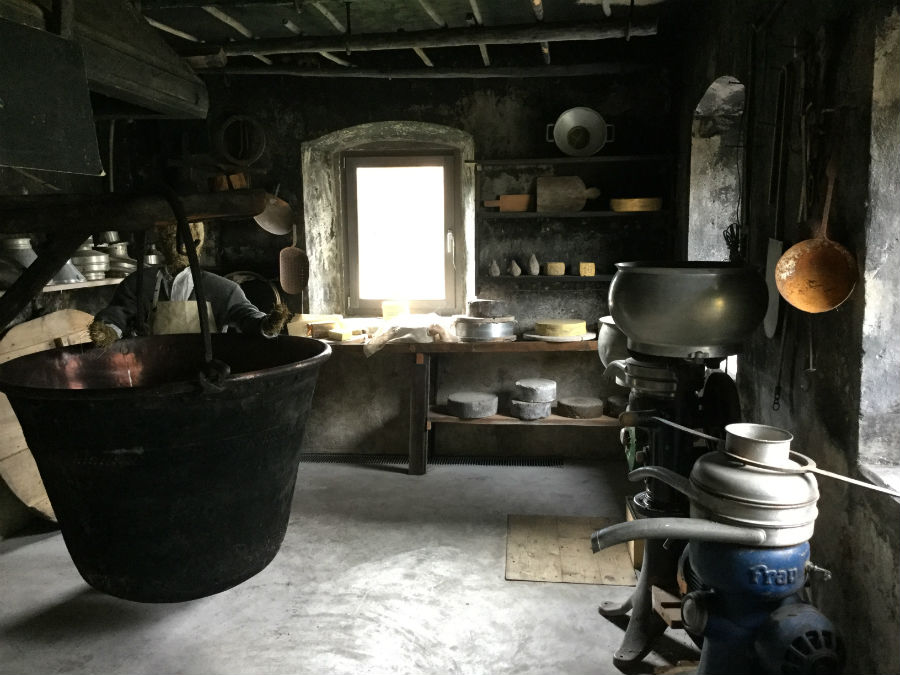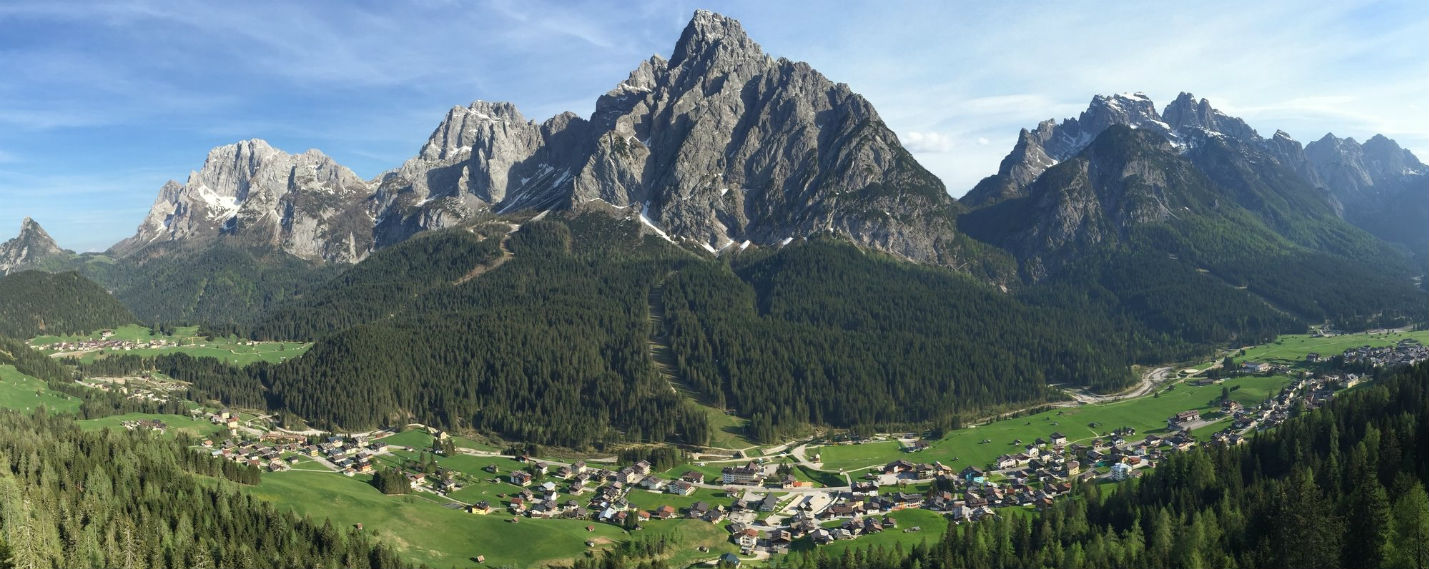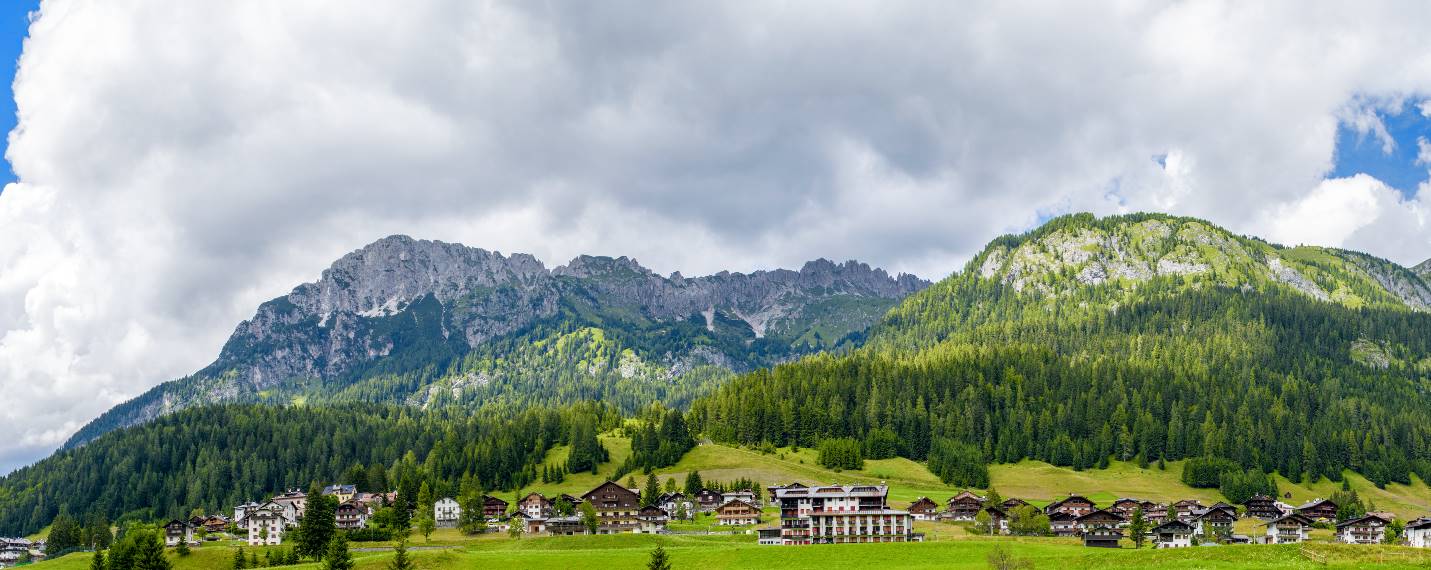Sappada
- Village in the mountain
- Suitable for disabled people
- Camper parking area
- Most beautiful villages in Italy
- Orange Flag Countries
About the village
The village of Sappada (Plodn in german dialect sappadino, Bladen in German, Sapade Ploden or in Friulano, Sapada in ladin language) is a linguistic island German-speaking, as well as a note summer and winter tourist resort. Located between the historical regions of the Cadore and of Carnia, the northern offshoots of the Dolomites, at the border between the regions of Veneto and Friuli and Carinthia (Austria). Sappada is surrounded by imposing and impressive Dolomite massifs, the landscape is characterized by green pastures and extensive woods of conifers; numerous waterfalls and the alpine lakes. A landscape still uncontaminated area in which the variety of animal and plant species live undisturbed.
The toponym Italian seems to be connected to the "zappare", the dialect "sapàr", while the toponym germanico is connected to "Plat", "Piave". In the XI century some families coming from the nearby Austria (according to legend by country of Villgraten in East Tyrol) settled in the valley. It is therefore a linguistic island, which has experienced further successive migration of families from the Val Pusteria. The valley was uninhabited and uncultivated and sappadini began a patient work of deforestation and cultivation; in short was born a small country formed from Masi, developed over time in the suburbs. The country consists of features wooden houses lie in the sunny northern slope of the valley. Around the village green pasture for cattle, fields of rye, oats, barley and legumes and besides they woods rich in game.
In 1500, in addition to agricultural activities and pastoralism prospered even timber trade thanks to strong demand for wood for boats on the part of the Republic of Venice. After a brief period of French domination in 1814 Sappada passed under the Austrians to whom we owe the first schools and public works. In 1852 Sappada passed from the province of Udine to that of Belluno which in turn, a few years later was annexd to Italy (1866). After the entrance in the administration bellunese, Sappada chose to adhere to the Magnificent Community of Cadore, while not being part of the historic territory of the Cadore.
During the first world war were not fought the decisive battles of the surrounding mountains but were maintained positions on the front, you can still find the artifacts. Many women also sappadine were bearers carniche, women who voluntarily fulfilled hundreds of meters of height difference to several times per day to supply food and ammunition italian soldiers to the front. From 1916 to 1917 the country was also evacuated because of the suspicion that the inhabitants could nourish sympathies wire-Austrian because of their dialect: the population was transferred in Tuscany (at the Commune of Arezzo was instituted the provisional seat of the municipality of Sappada), some arrived in Campania and Sicily. Only recently, following the approval of the Regional Law 2018 of 9 February n.4, Sappada was aggregated to the Friuli Vanezia Giulia region under the province of Udine.
In the Second World War the town became part of the free republic of Carnia and was the scene of clashes between partisans and Germans. Some sappadini were conducted to concentration camps, including Dachau. In the postwar period due to the shortage of work many sappadini emigrated abroad, in particular in Switzerland and Germany. Following the development of tourism has also changed the economy of the country and many emigrants returned home to devote itself to the tertiary activities. On 5 November, was officially twinned with Arezzo, Tuscan city that welcomed in its territory the sappadini during the first world war, when they were refugees from 1917 to 1919.
The architecture sappadina appears to be inspired by the nordic trends, with the predominance of rustic and houses completely in wood, which constitute the precious architectural heritage of the town. These houses are built with the ancient technique of blockbau to overlapping beams in horizontal recessed and corners. The typical blockhaus sappadine are located in Sappada Vecchia and Cima Sappada. Homes more recent you have in the Borgata Lerpa at the beginning of Sappada for who comes from the slope of Veneto and in part of Sappada center. 8 of 15 villages of Sappada (Mühlbach, Cottern, Hoffe, Fontana, Kratten, Soravia, Ecche and Puiche) constitute the so-called Sappada Vecchia, which walking along the road it is possible to admire the ancient and typical houses (blockhaus) that in summer have all colorful flowered balconies, and stables in wood built with system of the interlocking of the beams blockbau said. More isolated and feature is also the borgata Cima Sappada, with numerous rustic wood dating back to the XIX century.
The dialect of Sappada is similar to Bavaro Tyrolean-spoken in the communities of the Swiss-German speaking province of Udine as Sauris and Timau. For its particular characteristics, is often the object of studies; has recently been introduced in the classrooms of Sappada, as provided by Law 482/99 and by international treaties signed by Italy.
The folklore sappadino expresses itself through the dances and the music of the folklore group of Holzhockar (the loggers), composed of a good thirty elements, between dancers and musicians. The group performs the mimiche dances of the life of a time; with their typical costumes sappadini and the cheerfulness of dances and music animate the festivals and the feasts of the country. Traditions are numerous and kept alive. The most note relates to the Carnival with its festivities and the typical masks. Among the religious traditions, it should be recalled the annual pilgrimage to the Shrine of Our Lady of Sorrows in village Maria Luggau in Carinthia (Austria), that the sappadini and some tourists make on foot, through the path that in approximately 9 hours walk leads in Austria.
Today Sappada is a mountain resort tourist, which still retains its ancient traditions: in the characteristic houses in wood to the dialect Sappadino that has remained unchanged for centuries; from the local handicraft production of cheeses and cold cuts.
Village of Sappada
Municipality of Sappada
Province of Udine
Friuli-Venezia-Giulia Region
Population: 1.319 sappadini
Altitude centre: 1217 m s.l.m.
the Municipality is part of:
Paesi bandiera arancione
Unione Montana del Comelico e Sappada
Acknowledgments
Orange Flag - Italian Touring Club
Municipality
Borgata Bach 11 - Tel. +39 0435 469126
96.62 Kilometers from Sappada
77.83 Kilometers from Sappada
96.55 Kilometers from Sappada
98.43 Kilometers from Sappada
43.39 Kilometers from Sappada
57.63 Kilometers from Sappada
BY CAR
- From Veneto take the A27 Mestre-Belluno highway until the last Longarone exit, then continue to Pieve di Cadore. Near Auronzo di Cadore we turn to S.Stefano and here to Sappada.
- Those arriving from Friuli Venezia Giulia: follow the A28 Palmanova-Tarvisio and exit at Carnia / Tolmezzo; here continue on the SS 52, passing through Ovaro and Rigolato and Forni Avoltri until you reach Sappada.
ON THE TRAIN
- Calalzo di Cadore station
BY PLANE
- Venice-Treviso airport
- Ronchi dei Legionari airport
On 24 May 1915 Italy entered into war against Austria.
The Community sappadina, albeit of culture and language german, he felt italian patriotticamente. Some migrants, as the painter Pius Solero, returned to take part in the defense of the country; others took part of the body of the Alpine Volunteers of the Cadore or were enlisted in the army. The citizenship actively supported the soldiers: 19 sappadine women were engaged as bearers.
On the front of Comelico and Sappada there were battles such as to turn the tide of war but was made a huge effort to occupy and maintain positions in high altitude even during the harsh winters, since the outbreak of hostilities in spring 1915 up to the defeat of Caporetto and the consequent retraction of the forehead, in autumn 1917.
In the summer of 1915 the Italians occupied the Sesis step, then regained by the Austrians, and tempted the conquest of Monte Peralba from the west side. In March 1916 the Austrians Cimasappada bombed.
The winter between 1916 and 1917 was the more rigid and snowy of century: in Val Sesis a huge avalanche fell at night on the Italian camp, which was swept away, dragged downstream for more than half a kilometer, together with the 60 miserable military.
On 24 October 1917, following the offensive of Caporetto, were made to skip the ammunition in the spiazzo Plodar ròschte, hereinafter referred to as Pian delle Bombarde. Followed other clashes of minor importance until 28 October 1917 when, with the defeat of Caporetto, the opposite was retracted until the Piave.
The 28 - 29 October 1917, under the pressure of the military, a large part of the population was evacuated. For the 233 families, a total of 841 people, began a period of profugato.
The population was met first in Santo Stefano di Cadore, where trucks with 650 sappadini went to Calalzo, to be loaded on the train. 160 laggards, instead, stood for three days at the station after having met the Italian troops retreating, who believed that the war was over. The first train, with 650 villagers, stood in Florence, from where the refugees were transferred to Arezzo and surroundings. The 160 laggards were brought to Fano, Marche, where they were hosted about a month and then spliced to others.
At Arezzo took place extra-territorial City Hall of Sappada. The Committee refugees gave the necessary for sleeping, eating and dressing. Many families were housed in the villas of the campaign. The Government gave a grant of a few lira for a living. During the summer 1918 72 sappadini died because of a serious outbreak of influenza: the Spanish.
The 337 people who have remained in the country lived in the difficult moments of employment: the abandoned houses were closed and guarded, the few food supplies were collected, the beasts without owners were pooled in the stables of those who had remained. The invaders effettuarono robberies and continuous searches.
At the end of the conflict the refugees remained in Tuscany until the next spring: on 22 March 1919, with a translated, came to Villa Santina and from there with the trucks were reported in Sappada, where they found homes devastated and empty stables. A couple of months before the final repatriation the heads of the families returned to the country to restore what was destroyed and provide food supplies.
There followed a period of misunderstandings and internal conflicts; following the community regained serenity and cooperation.
- February - Carnival of Sappada (Plodar Vosenocht). Unwinds for three Sundays, each of which is dedicated to a social class, the Sunday of the Poor (Pettlar Sunntach), one of The farmers (Paurn Sunntach) and the one of the Lords (Hearn Sunntach). The protagonist of the Carnevale Sappadino is the typical sappadina mask of rolled, character who wears a heavy fur similar to that of a bear and trousers to rows in the canvas, the face is covered by the typical mask carved in wood by local craftsmen, also brings with it the balls of lagate bronze in life that resonate loudly to indicate its passage and a broom of straw which is used jokingly against some avventore. Moreover the Carnival Sappadino provides on Fat Thursday, with a parade of rolled along the streets of the country, the Monday grasso, day dedicated to the rolls and on Shrove Tuesday during which a race masked on skis, No club. The rolled became in time the symbol of Sappada.
- July - Hamlets Feast. Along the track of the villages of Sappada Vecchia, kiosks and food stands with sale of handicraft products.
- July - Festival of folklore. Organized by 1999 from local folk group of Holzhockar (the loggers), Parade and performances by folk groups from various parts of the world along the streets of the country and in the final evening.
- July - International Congress of Dialectology. Organized by the Department of Linguistic and Literary Studies of the University of Padua, recalls in Sappada the greatest scholars of linguistics and dialectology of Italy and, sometimes, of the world.
- July and August - Musical Holidays in Sappada. Event founded by Master Paolo Pellarin.
- August - Feast of Sant'Osvaldo to Cima Sappada. Gastronomic Stand, sale of local products and gastronomic delights, cross country, music and dancing.
- Mid August - Hay Feast.
- September - SappaMukky. The fair of products and of the Alpine farm, at the Palazzetto dello Sport, gastronomic stands, music and entertainment, tasting of local products, games and animation.
Sleep, eat, buy...
11.38 Kilometers from Sappada
41.22 Kilometers from Sappada
13.20 Kilometers from Sappada
81.24 Kilometers from Sappada
70.44 Kilometers from Sappada
43.60 Kilometers from Sappada
96.69 Kilometers from Sappada
70.29 Kilometers from Sappada
10.90 Kilometers from Sappada
43.47 Kilometers from Sappada
11.34 Kilometers from Sappada
11.22 Kilometers from Sappada
11.54 Kilometers from Sappada




